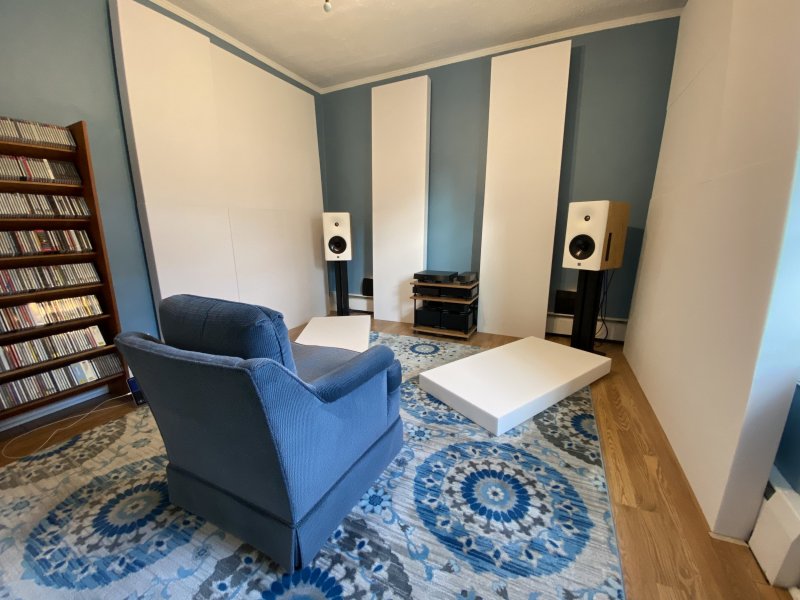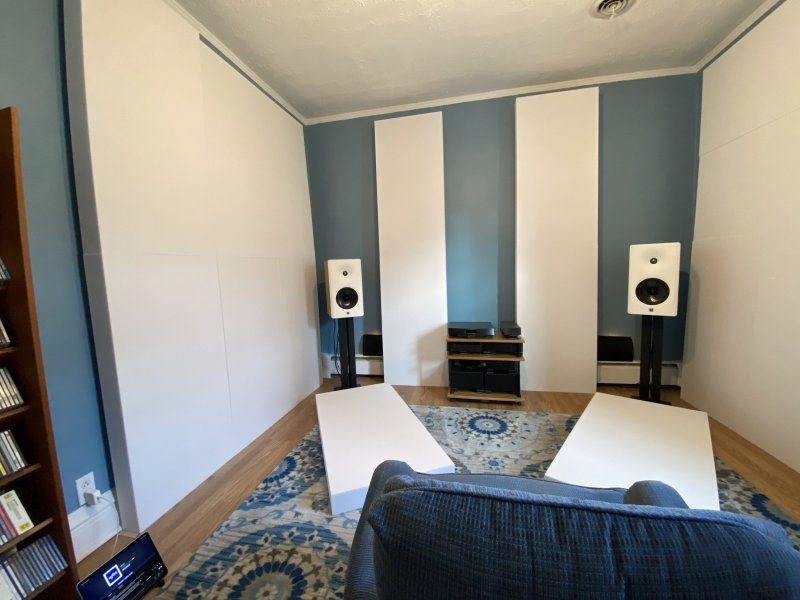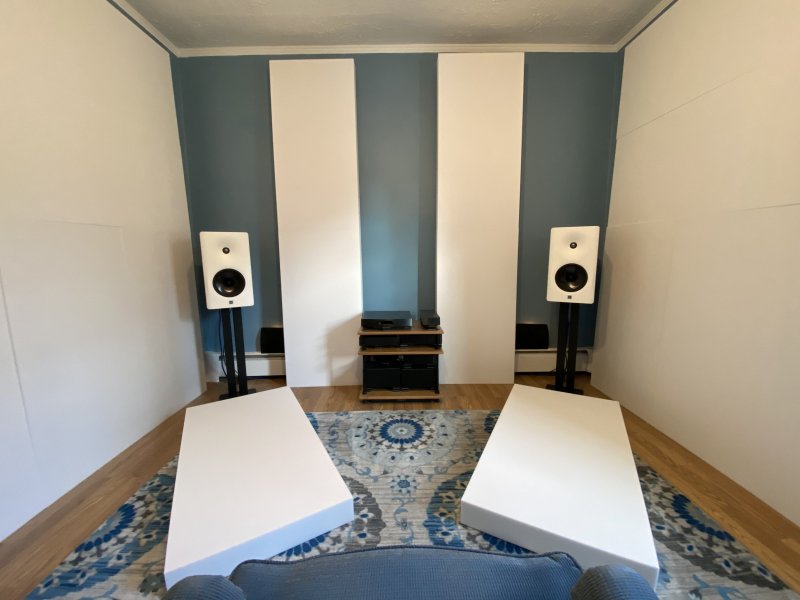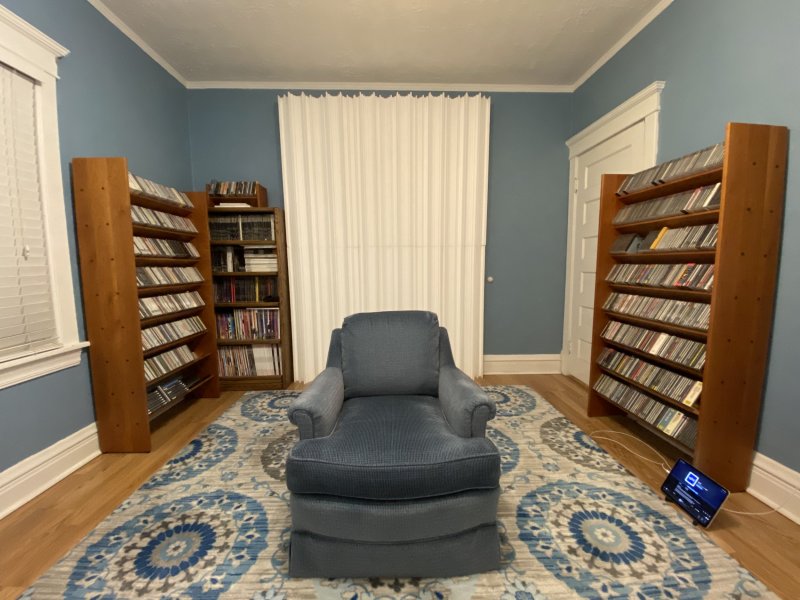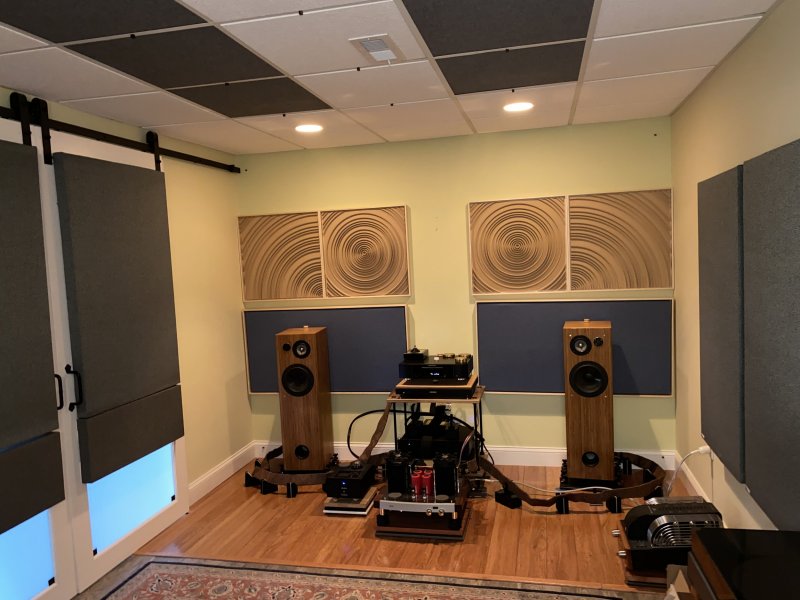I've been using acoustical treatments for my listening rooms since about 1984 which was when my listening area went from a shared space to a dedicated space. Then, as now and at all times in between, my audio rooms have been rather small, especially in terms of the width dimension, meaning that the speakers and listening position usually ended up within no more than a few feet (often closer) from the walls. I have never had an audio room whose dimensions allowed the speakers to be placed ten feet or more from the walls beside and behind them. Such distances would probably allow any reflections of sound from the room surfaces to take the subjective form of pleasing reverberation, rather than annoying echo, brightness, or brittleness. And unless you're dealing with mid-air mounting of speakers in a massive ballroom or auditorium, there is no speaker position which will place the speakers ten feet away from both the floor and ceiling.
My earliest efforts at treating room acoustics involved pinning unused blankets and towels to room surfaces in an effort to cut down on the audible "slap echo" one hears in a small room when critically listening to an audio system. While I have a few pictures of those early efforts, I won't bother posting them. Trust me, the visual effects were, as you can imagine, rather patch work in nature—not appealing at all. Sonically, yes, it was an improvement in terms of reducing high-frequency glare and a bit of echo, but I could clearly tell that something more effective was still needed.
After blankets, I moved on to using Sonex acoustic foam as my primary acoustic treatment, first in three-inch thicknesses and later in the four-inch-thick version. My use of Sonex was influenced strongly by an article Bert Whyte wrote in Audio magazine about using Sonex to create an LEDE (Live-End, Dead-End) listening room. Because of its futuristic/space-age pattern (the wedge pattern was often part of Star Trek episode decor, for example) Sonex, even in its thicker versions, could be easily mounted to drywall surfaces using an electric staple gun (as Bert Whyte recommended) rather than adhesives. It could thus be moved around with comparative ease without damaging the room surfaces too much. Usually touch up paint could cover the staple holes even without any spackling, assuming your room, like mine, was painted with latex flat paint in a forgiving color such as the classic construction favorite, Glidden Bone.
I used Sonex in my listening rooms for decades. It was only upon my purchase of the Janszen Valentina Active speakers that David Janszen suggested to me that I might want to try acoustic diffusers in place of some of my sound absorbing Sonex pads.
Thus, for the past few years I've been leaning heavily on dispersive room treatment, primarily in the form of the P. I. Audio Group AQD1 Quadratic Residue Diffusers. These are basically 47.5" x 23.5" x 6" panels made of polystyrene, the type of "hard" foam material used my some manufacturers of electronic equipment for custom packing moldings inside the shipping box. The price is certainly right: a box of two male/female mated pairs of these costs only $160 in unpainted white, which is what I've used recently. Before that, with the Janszen speakers I also owned a set of grey panels which P.I. Audio custom painted before shipment to me; painted, they cost $200 for two pairs.
These P.I. Audio Group diffusers have proved fine for treating my small room acoustics as long as I use enough of them. They excel with speakers which have more controlled mid- and high-frequency dispersion. They are at their best where the speakers sound quite "closed in" or even "dull" outside the sweet spot, as is definitely the case with the hyper-directional Janszen Valentina Active speakers I had in my room. These speakers used a side-firing "Air Layer" tweeter to help open up the sound of the speakers (make them "airier" sounding, if you will) when heard from outside the sweet spot. Placing the AQD Diffusers on the side walls and wall behind the speakers in the areas where, from the listening position, one could see any part of the speaker reflected in a mirror placed flat against the wall, eliminated any harsh reflections of treble energy from the flat walls, breaking up the reflection by scattering it in multiple directions—dispersing the reflection rather than allowing it to reflect—as from a mirror—off the smooth surfaces of my room.
In other words, in my small room, in situations where I do not want the speakers to sound any duller in terms of room sound than they already do without room treatment, these diffusers and other diffusive treatments, such as CDs on the variably angled shelves of my Stor-a-Disc CD racks, or wooden venetian blinds covering windows, work well.
These diffusers also have proved pleasing in their effect with speakers with much broader dispersion, including Harbeth M40.2, Gradient 1.4, and now my Dutch & Dutch 8c models. Granted, all of these have more "controlled" dispersion than speakers which are billed as "wide dispersion," much less "omnidirectional." I strongly suspect that with such speakers, especially in a small room such as mine, a good deal of absorptive room treatment would be beneficial.
With the Harbeths, as with the Janszens, I used a combination of absorbing Sonex foam and the P.I. Audio diffusers. But with both the Gradient 1.4s. and now my Dutch & Dutch 8c speakers, I've had great success with banishing Sonex from the room entirely and relying on using a lot of the diffusion panels to break up reflections and keep the room quite "live" sounding without any echo or harshness audible on music material.
I also strongly suspect that the subjectively pleasing effects I've heard from using all-dispersive room treatment with the Gradients and D&Ds relate to the uncharacteristic smoothness of the off-axis response of both speakers. Gradient speakers have off-axis frequency response which is quite smooth below 8 kHz or so. See, for example, John Atkinson's lateral measurements of the Gradient Revolution in Figure 4 on this page. The D&Ds are even better, with only a smooth gentle rolloff in the measured response to the sides of the primary axis of the speaker; see Atkinson's measurements in Figure 3 on this page. Most speakers are not nearly so smooth in their off-axis response. The smoothness probably decreases the necessity of absorbing the off-axis sound which would otherwise reflect off room surfaces since the off-axis response from these speakers is not as colored as it is with most speakers compared to the response on the design axis.
With the Dutch & Dutch speakers especially, even an untreated room does not sound obnoxious in the way it does with most speakers. Yes, all program material sounds livelier than it probably should. This is most evident when critically listening to the sound of radio announcers in a studio (which is almost universally a small dead-sounding space) or the Clap Track test tone on the Sheffield/XLO Test & Burn-In CD. But on most music, the added reverb creates a more open sound, a bit more liveliness, but rarely sounds obnoxious. Diffusive room treatment reduces the added liveliness, but even with large portions of the room surface treated does not make the sound dull or closed in. Diffusive room treatment also improves all aspects of the spatial performance of loudspeakers in my small room compared to untreated room surfaces.
My earliest efforts at treating room acoustics involved pinning unused blankets and towels to room surfaces in an effort to cut down on the audible "slap echo" one hears in a small room when critically listening to an audio system. While I have a few pictures of those early efforts, I won't bother posting them. Trust me, the visual effects were, as you can imagine, rather patch work in nature—not appealing at all. Sonically, yes, it was an improvement in terms of reducing high-frequency glare and a bit of echo, but I could clearly tell that something more effective was still needed.
After blankets, I moved on to using Sonex acoustic foam as my primary acoustic treatment, first in three-inch thicknesses and later in the four-inch-thick version. My use of Sonex was influenced strongly by an article Bert Whyte wrote in Audio magazine about using Sonex to create an LEDE (Live-End, Dead-End) listening room. Because of its futuristic/space-age pattern (the wedge pattern was often part of Star Trek episode decor, for example) Sonex, even in its thicker versions, could be easily mounted to drywall surfaces using an electric staple gun (as Bert Whyte recommended) rather than adhesives. It could thus be moved around with comparative ease without damaging the room surfaces too much. Usually touch up paint could cover the staple holes even without any spackling, assuming your room, like mine, was painted with latex flat paint in a forgiving color such as the classic construction favorite, Glidden Bone.
I used Sonex in my listening rooms for decades. It was only upon my purchase of the Janszen Valentina Active speakers that David Janszen suggested to me that I might want to try acoustic diffusers in place of some of my sound absorbing Sonex pads.
Thus, for the past few years I've been leaning heavily on dispersive room treatment, primarily in the form of the P. I. Audio Group AQD1 Quadratic Residue Diffusers. These are basically 47.5" x 23.5" x 6" panels made of polystyrene, the type of "hard" foam material used my some manufacturers of electronic equipment for custom packing moldings inside the shipping box. The price is certainly right: a box of two male/female mated pairs of these costs only $160 in unpainted white, which is what I've used recently. Before that, with the Janszen speakers I also owned a set of grey panels which P.I. Audio custom painted before shipment to me; painted, they cost $200 for two pairs.
These P.I. Audio Group diffusers have proved fine for treating my small room acoustics as long as I use enough of them. They excel with speakers which have more controlled mid- and high-frequency dispersion. They are at their best where the speakers sound quite "closed in" or even "dull" outside the sweet spot, as is definitely the case with the hyper-directional Janszen Valentina Active speakers I had in my room. These speakers used a side-firing "Air Layer" tweeter to help open up the sound of the speakers (make them "airier" sounding, if you will) when heard from outside the sweet spot. Placing the AQD Diffusers on the side walls and wall behind the speakers in the areas where, from the listening position, one could see any part of the speaker reflected in a mirror placed flat against the wall, eliminated any harsh reflections of treble energy from the flat walls, breaking up the reflection by scattering it in multiple directions—dispersing the reflection rather than allowing it to reflect—as from a mirror—off the smooth surfaces of my room.
In other words, in my small room, in situations where I do not want the speakers to sound any duller in terms of room sound than they already do without room treatment, these diffusers and other diffusive treatments, such as CDs on the variably angled shelves of my Stor-a-Disc CD racks, or wooden venetian blinds covering windows, work well.
These diffusers also have proved pleasing in their effect with speakers with much broader dispersion, including Harbeth M40.2, Gradient 1.4, and now my Dutch & Dutch 8c models. Granted, all of these have more "controlled" dispersion than speakers which are billed as "wide dispersion," much less "omnidirectional." I strongly suspect that with such speakers, especially in a small room such as mine, a good deal of absorptive room treatment would be beneficial.
With the Harbeths, as with the Janszens, I used a combination of absorbing Sonex foam and the P.I. Audio diffusers. But with both the Gradient 1.4s. and now my Dutch & Dutch 8c speakers, I've had great success with banishing Sonex from the room entirely and relying on using a lot of the diffusion panels to break up reflections and keep the room quite "live" sounding without any echo or harshness audible on music material.
I also strongly suspect that the subjectively pleasing effects I've heard from using all-dispersive room treatment with the Gradients and D&Ds relate to the uncharacteristic smoothness of the off-axis response of both speakers. Gradient speakers have off-axis frequency response which is quite smooth below 8 kHz or so. See, for example, John Atkinson's lateral measurements of the Gradient Revolution in Figure 4 on this page. The D&Ds are even better, with only a smooth gentle rolloff in the measured response to the sides of the primary axis of the speaker; see Atkinson's measurements in Figure 3 on this page. Most speakers are not nearly so smooth in their off-axis response. The smoothness probably decreases the necessity of absorbing the off-axis sound which would otherwise reflect off room surfaces since the off-axis response from these speakers is not as colored as it is with most speakers compared to the response on the design axis.
With the Dutch & Dutch speakers especially, even an untreated room does not sound obnoxious in the way it does with most speakers. Yes, all program material sounds livelier than it probably should. This is most evident when critically listening to the sound of radio announcers in a studio (which is almost universally a small dead-sounding space) or the Clap Track test tone on the Sheffield/XLO Test & Burn-In CD. But on most music, the added reverb creates a more open sound, a bit more liveliness, but rarely sounds obnoxious. Diffusive room treatment reduces the added liveliness, but even with large portions of the room surface treated does not make the sound dull or closed in. Diffusive room treatment also improves all aspects of the spatial performance of loudspeakers in my small room compared to untreated room surfaces.
Last edited:


